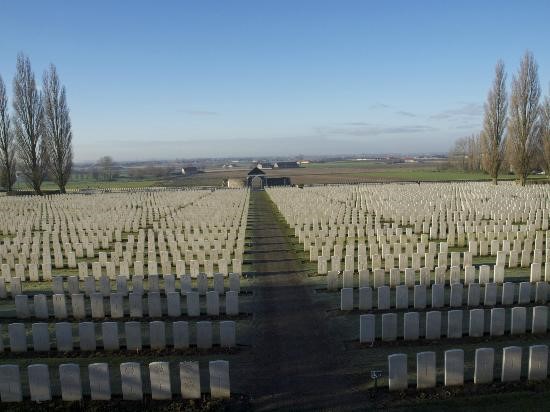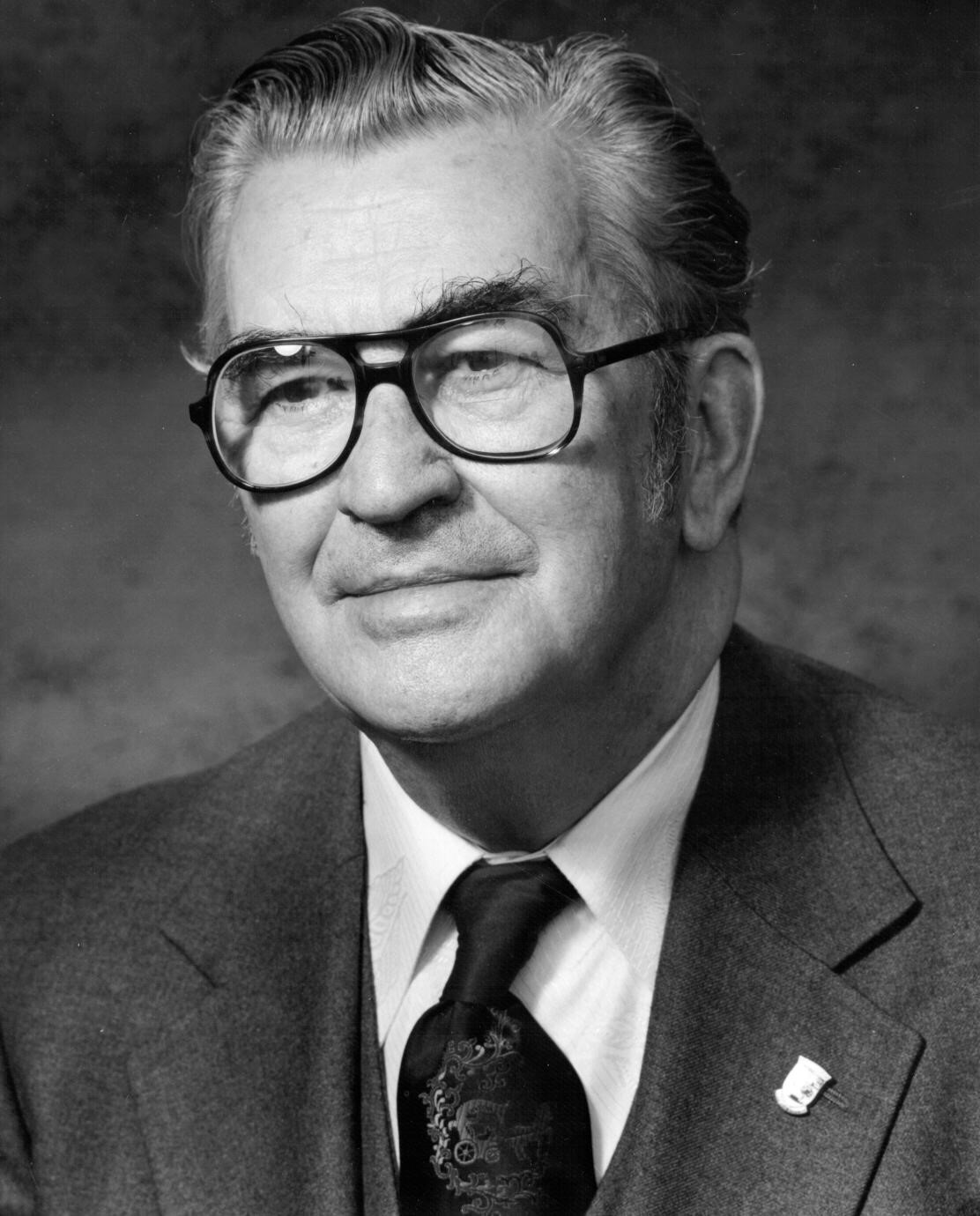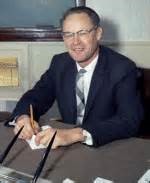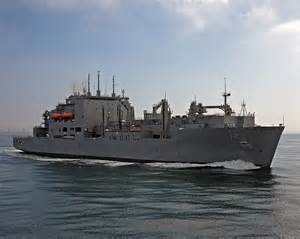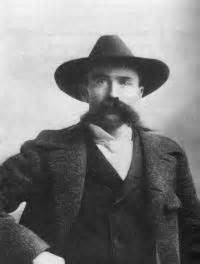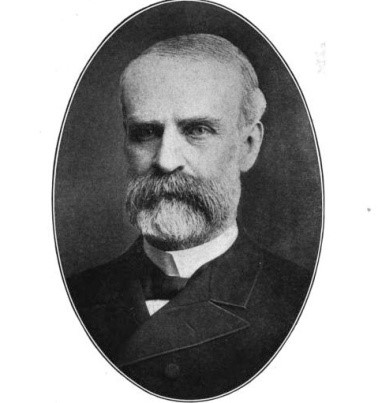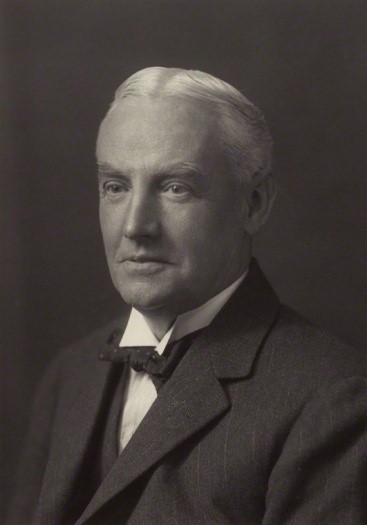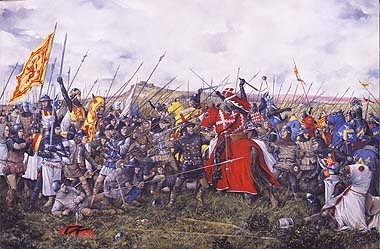Clan Maclean Heritage Trust
Anniversaries
The following Maclean anniversaries fell in 2014.
100 years
The First World War began on 28th July 1914, when Austria-Hungary declared war on Serbia. Britain declared war on 4th August 1914. The Commonwealth War Graves Commission (http://www.cwgc.org/) records the names of more than 1,000 Macleans (in various spellings) who died in this war and whose graves are marked.
On 30th August 2014, at a commemorative service held at the Menin Gate Memorial at Ypres in Belgium, Clan Maclean, represented by Ken Maclean, Baron of Denboig, laid a wreath to honour all members of the Clan who gave their lives in this war.
The Hon. J. Angus MacLean PC, OC, DFC was born and died in Prince Edward Island. He served with the Royal Canadian Air Force during World War II. The story of his bomber being shot down over Holland in 1942, how he evaded capture for three months, despite having injured his back when landing by parachute, and his return to the UK via Belgium, France and Spain, is told in his memoirs, Making It Home (1998).
He was first elected to Parliament in 1951 and held his seat continuously until he resigned in 1976, having been re-elected nine times. He served as Minister of Fisheries from 1957 until 1963. He was elected Leader of the Progressive Conservative Party of Prince Edward Island in 1976 and led his party to victory in the 1979 election. He was Premier of Prince Edward Island from May 1979 until he retired from this post in November 1981.
He died in Charlottetown on 15th February 2000.
On 14th September 2013 the Clan Maclean Heritage Trust joined with Clan Maclean Atlantic Canada, the local Belfast Historical Society and the Caledonian Club of Prince Edward Island, as well as members of J. Angus MacLean's family, to unveil a plaque and a storyboard commemorating his achievements. A report on this event is available here.
A farmer all his adult life, Ron McLean was active in many local rural organisations. He chaired the Kennington section of Federated Farmers of New Zealand, and later became Southland president (1964–66) and a national councillor. He was a member of the electoral committees of the New Zealand meat and wool boards, chairman of the Waimatua Rabbit Board, and a director of the Southland Co-op Phosphate Company and the Southland Cement Company.
His most notable contribution, however, was to the Save Manapouri Campaign in the late 1960s and early 1970s, when Lakes Manapouri and Te Anau were threatened by hydroelectric development. The Manapouri–Te Anau Development Act 1960 required the construction of a dam on the lower Waiau River which would have raised the level of Lake Manapouri by up to 11 metres, with serious consequences for the local environment. It was later revealed that Lake Te Anau would also be seriously affected. McLean was involved with the formation of the campaign in Invercargill in October 1969 and later served as co-convener and chairman of its Southland committee and as president of the national campaign throughout its existence.
The issue was finally resolved after the election of the Labour government in 1972, when the new prime minister, Norman Kirk, honoured his party’s pre-election pledge not to raise the levels of the lakes.
Ron McLean’s effective and untiring efforts to save the lakes helped considerably to raise the profile of nature conservation and promote the concept of integrating conservation with development. He was selected as Man of the Year for 1970 by the Dominion newspaper. He was made an MBE in 1974. The Save Manapouri Campaign, to which McLean devoted the last decade of his life, has come to be recognised as the greatest environmental debate in New Zealand's history and a watershed in the country’s transition from the pioneering era of resource exploitation to the sustainable management of its natural and physical resources.
Ron McLean died at Kennington on 26th May 1980.
Bill McLean studied at the California Institute of Technology, where he received his Bachelor of Science degree in 1935, his Masters degree in 1937 and his doctorate (Ph.D) in 1939 with a thesis on the short-range alpha particles produced by the bombardment of fluorine by 350 KEV protons.
After a spell in Iowa, where he had a post-doctoral fellowship in nuclear physics, in 1941 Bill moved to the Bureau of Standards in Washington to lend his energies to the war effort. His assignment was primarily to work with proximity fuses, but he also worked on rockets, arming devices, fire control systems, and acceleration integrators.
In 1945 he accepted an invitation to join the new Naval Ordnance Test Station (NOTS) at China Lake, California, and stayed there for the next 22 years. Bill's first post was head of the Ordnance Division, which soon became the Aviation Ordnance Department. Nine years after joining NOTS, in 1954, he was appointed technical director, the most senior civilian position at the Station, and held this post until July 1967, when he was appointed head of the newly formed Naval Undersea Warfare Center at San Diego. He remained there for 7 years until his retirement in 1974.
He is most famous for designing and developing the Sidewinder air-to-air missile, which used infrared radiation from the target aircraft as its source of guidance information. This was the first truly effective air-to-air missile; its variants and upgrades are still in active service today. It is simple, accurate, reliable, and low cost. For this work, in 1956, the Navy awarded him $25,000. In presenting the award, the Chief of Naval Operations, Admiral Arleigh A. Burke, told the assembled group that nothing since the atomic bomb "had done so much for the Navy" as the Sidewinder missile.
Bill McLean was a physicist, an engineer and above all an inventor, with a wide range of interests. Because he enjoyed scuba diving at a time when very few people had even heard of the sport, he designed his own wet suit and pressure regulator. He enjoyed open-sea boating and designed water vehicles for personal use, even small submarines with glass domes for visibility. His interest in underwater activities was reflected in the programme at NOTS. Deep diving vehicles and cable controlled vehicles were designed and built. One of these, CURV (cable controlled underwater research vehicle), was used in 1966 to help recover the hydrogen bomb that was lost off the coast of Spain.
He died in San Diego, California, on 25th August 1976 after a long illness.
The Memorial Award for Dr. William B. McLean was established in 1968, to recognize creativity in employees who furthered the mission at China Lake with significant inventions. In 2008, the Navy announced that the new dry cargo/ammunition ship USNS William McLean (T-AKE-12) would be named in honour of Dr. McLean. It was launched in April 2011.
We commemorated earlier the 100th anniversary of his flight in a seaplane through Tower Bridge on 10th August 1912 (see 2012 Anniversaries). In 1913 Frank McClean turned his attention to Egypt, perhaps prompted by the fact that the French National Air League had just issued a challenge to test the viability of long-distance air travel by flying from Paris to Cairo. He commissioned from Short Brothers a new seaplane, the S.80, that could carry three passengers, with a view to flying from Alexandria in Egypt to Khartoum in Sudan, a distance of about 1,500 miles.
The flight was beset by mechanical problems, resulting in frequent lengthy stopovers, while spare parts were sent out from England. The group eventually arrived in Khartoum on 22nd March 1914.
Although as the result of these delays Frank McClean was not the first to complete the journey - he was overtaken by a French pilot in a wheeled monoplane - his achievement was arguably the more important. It demonstrated that Africa was accessible by aircraft without the difficulty and expense of creating airfields. It also helped to establish Egypt, and specifically Cairo, as a major stopover point for flights not only to Africa but eventually also to India and Australia.
Although best known for being the inspiration for Jack London's The Sea-Wolf (which in turn is best known from the 1941 film of the book, starring Edward G. Robinson as Captain Wolf Larsen), Alex MacLean was a much more rounded and interesting character than his fictional portrayal.
He was certainly one of the greatest mariners of the late nineteenth century and one of the last great seal-hunters. But he also had as much political savvy, or at least an appreciation of the workings of imperial power politics, as he did an understanding of the sea. Becoming a U.S. citizen in 1882, before making San Francisco his homeport, is one example of this political nous, and MacLean’s confrontations with the Russians and the Japanese, not to mention his numerous testimonies in court, are others. MacLean’s appearances before commissions and in courts in particular always showed him to be in command of his facts and the situation generally, whether political, legal or nautical.
Alex MacLean was born on 15 May 1858 in East Bay, Cape Breton County, Nova Scotia, which he left at the age of 16 for the Eastern Seaboard. In 1879 he worked his passage to San Francisco on the Santa Clara. By 1881 Alex was in Victoria as mate on the Sir James Douglas. He travelled the coast between San Francisco and Alaska and dabbled in prospecting. Victoria in British Columbia became Alex’s main base in the 1880s. He and his brother Dan were among the first to engage in pelagic [open sea] sealing in the Bering Sea, and Victoria would be the home port for the Canadian sealing fleet in the Pacific.
From 1883 Alex and Dan were harvesting huge numbers of seals. Eventually, in 1891, the British and American governments agreed to prohibit sealing in the eastern Bering Sea for a year, and like other Canadian and American sealers Alex turned to the Russian side of the sea and to the coast of Japan. That summer, Alex was caught while raiding the rookeries of the Komandorskiye Islands. He and his crew spent the next few months in Russia, primarily in Vladivostok.
The years 1894–95 were not successful sealing seasons and signalled the end of the MacLeans’ participation in the regular sealing fleet. Their departure coincided with the decline of the industry.
In September 1896 Alex returned to Victoria as an expert witness for the American government at the hearings of the Bering Sea Claims Commission. His appearance there was followed by an unsuccessful mining expedition in the Solomon Islands, which ended with Alex sailing the Sophia Sutherland hundreds of miles, possibly single-handed, because most of the crew had yellow fever. Eventually he reached Apia (Western Samoa). Alex was then attracted to the Klondike and Alaskan gold-rushes.
By 1902 he was back in San Francisco and for the next three years he continued his sealing activities, flouting a host of regulations in the process and evading capture by the authorities. In mid-September 1905, however, he returned to Victoria, was brought to court and fined. His sealing days were now over, as were his sojourns in the United States. Later he ran explosives up the Skeena River and operated a small tug out of Vancouver.
MacLean drowned in 1914 when he slipped going aboard a tug boat in False Creek, Vancouver. He was 56 years old.
Born Kate Seymour in Fulton, New York in 1827 or 1828, daughter of Frederick and Maria (née Gardner) Seymour, she was a teacher by profession. She moved to Canada after marrying Allan Maclean of Ingersoll, Ontario. They moved to Kingston, Ontario, when Allan became an officer of the Hospital for the Insane there. She died in Toronto in 1913 or 1914 at the age of 86.
She published her poetry in literary magazines such as Canadian Monthly and National Review, Queen's College Journal and The Week. Three collections of her poems were published as books:
- - The Coming of the Princess; and Other Poems (Hunter, Rose & Company, Toronto, 1881)
- - Advent days and poems of remembrance (Jackson Press, Kingston, Ontario, 1902)
- - From the balcony and other poems (Jackson Press, Kingston, Ontario, 1904)
The Coming of the Princess contains an Introduction by Graeme Mercer Adam, the editor of Canadian Monthly, who speaks highly of her. A more nuanced appraisal, running the gamut from great to hopeless, is included in Life and Times of the Right Honourable Sir John A. Macdonald: Premier of the Dominion of Canada by Joseph Edmund Collins, pp 483 and 485-486 (Rose Publishing Company, Toronto, Canada, 1883). In Songs of the Great Dominion: Voices from the Forests and Waters, the Settlements and Cities of Canada by William Douw Lighthall, p xxxiii (Walter Scott, London, 1889), which is a key early anthology, she is described as "mistress of a style of singular richness", although none of her poems are actually included in the anthology, nor is she included among the "Notes Biographical and Bibliographical" at the end of the book. Two of her poems are however included in A Treasury of Canadian Verse, with Brief Biographical Notes by Theodore H Rand, pp 208-210 and 397 (E P Dutton & Co, New York, 1900).
Kate Seymour Maclean was a well-known and highly regarded poet in her day but has since been largely overlooked. She does not appear in recent anthologies such as the New Oxford Book of Canadian Verse in English, selected by Margaret Atwood (Oxford University Press, 1985). Early Canadian writers are however now being re-assessed and it will be interesting to see how she is judged by posterity.
John Knox McLean was born on 31st March 1834 in Jackson, New York. He graduated from the Princeton Theological Seminary in 1861 and was ordained pastor firstly of the Congregational Church of Fair Haven, New York and then of the Hollis Evangelical Congregational Church in Framingham, Massachusetts. He went on to pastor in the Congregational Church of Springfield, Illinois.
In April 1872 he and his wife moved to Oakland, California where he became pastor of the First Congregational Church in Oakland. He remained in that post until 1895.
He was a delegate to the First International Congregational Council, which met in London in 1891, and Assistant Moderator of the Second Congregational Council which met in Boston in 1899. He was also a corporate member of the American Board of Commissioners for Foreign Missions and a vice-president of the American Home Missionary Society.
For many years he was a Director of the California Home Missionary Society and was president of the California Chinese Mission from its formation until 1901. He was largely responsible for the foundation of the Associated Charities of Oakland and its President from 1884 to 1894.
Besides his pastorate, he considered as his most important work his involvement with the Pacific Theological Seminary (now the Pacific School of Religion), where he joined the Board of Trustees in 1872 and served as the Board's President from 1880 to 1910. In 1893 he became President of the Seminary. In 1901 McLean organised for the Seminary to move from Oakland to Berkeley, so that it could establish a close relationship with the University of California, which he believed was necessary in order for the Seminary to thrive. In 1912 he was elected President Emeritus of the Seminary.
In 1903 Governor George Pardee appointed McLean to the first California State Board of Charities and Corrections, and in 1906 he was elected chairman. During 1887-1897 he was a Director of the State Institution for the Deaf, Dumb and Blind.
McLean was also a close friend of Susan B. Anthony and a friend and supporter of the women’s suffrage movement. He became a strong advocate for the inclusion of women on the faculty at the University of California.
He died at his home in Berkeley in 1914, just short of his 80th birthday. The cross on his gravesite in Mountain View Cemetery is a replica of the Maclean Cross on Iona.
150 years
Sir Donald was a solicitor by profession, having been admitted in 1887, and he practised law all his life. In the 1920s he was elected to the Council of the Law Society and was elected Vice-President in 1932.
His first parliamentary seat was Bath, where he was elected in 1906. In 1910 he was defeated in Bath but became the member for Peebles & Selkirk later in the same year. In 1911, he became Deputy Chairman of Ways and Means. In 1916 he became a Privy Councillor, and in the same year was appointed Chairman of the Treasury Committee on Enemy Debts and also of the London Military Appeal Tribunal. In 1917 he was created KBE, and received another Chairmanship, this time of the Reconstruction Committee on the Poor Law.
When Lloyd George's coalition government was formed in December 1916, a split in the Liberal Party developed between Lloyd George and Asquith, who had been Prime Minister for the previous eight years. Maclean took Asquith's side. At the December 1918 election, when Asquith lost his seat, Maclean was one of a small number of independent Liberals re-elected and was elected Chairman of the Independent Liberal Party, becoming effectively Leader of the Opposition in the absence of effective opposition from the parliamentary Labour Party. Even after February 1920, when Asquith returned to Parliament at the Paisley by-election, Maclean remained chairman of the non-coalitionist Liberal MPs.
In October 1922 the coalition collapsed and in the general election that followed Maclean lost his seat. He was unsuccessful in elections in 1923 and 1924. In 1929, however, he won the seat of North Cornwall from the Conservatives and held it until his death. When the National Government under Ramsay MacDonald was formed in August 1931, Maclean was appointed President of the Board of Education, though initially without a seat in the Cabinet. He was however elevated to the Cabinet in November 1931, following the October 1931 election.
While out of Parliament, Maclean generated income from legal work and newspaper boards, together with directorships of the Cardiff Exchange and Office Ltd and Hudson and Kearn's Ltd, of which he became chairman in 1926.
He was also active in social campaigns. He was among the founders of the National Society for the Prevention of Cruelty to Children, acting as secretary of its Cardiff branch and later as its national solicitor.
In 1907 he married Gwendolen Devitt and they had one daughter and four sons. The third son was Donald, the famous spy who fled to Russia in 1951 (see 2013 Anniversaries). As the result the youngest son, Alan, was forced to abandon his own career in the Foreign Office and he became a highly regarded publisher, ending as editorial director of Macmillan.
Maclean died from a heart attack at his London home on 15th June 1932, aged 68.
McLean was born in 1805 in Tobermory. He joined the Hudson's Bay Company in 1833 as an apprentice clerk in the company's Western Department. In 1835 he was with expeditions to the Snake River country west of the Rockies. He was assigned to Fort Colville in 1839 and in 1840 was transferred to Flathead Post. Two years later, he was sent to the New Caledonia Fur District in now north-central British Columbia, and was, at different times, in charge of Forts Chilcotin, Babine, and McLeod.
McLean was appointed Chief Trader in 1853, taking charge of Thompson's River Post (today's Kamloops) in 1855, expanding its cattle and horse herds and managing unruly relations with indigenous peoples sternly, acquiring a reputation both for fairness and severity.
McLean was known as "Samadlin" to his indigenous customers and friends, which is a corruption of Sieur McLean, which is how he was addressed by his French-Canadian underlings at the fur posts.. McLean's brutal practices - he was an adherent of an informal company policy known as "Club Law" - and various insubordinations led to him being called to company regional headquarters in Victoria in 1860 and ultimately to his resignation in 1861.
During his tenure at Thompson's River Post, McLean had established a ranch in the hills northwest of Cache Creek. He now moved there with his family, ranching, prospecting, and running a roadhouse on the Cariboo Road at Lower Hat Creek (now a heritage museum and visitor attraction).
McLean came out of retirement during the so-called Chilcotin War of 1864 to assist in the hunt for the Chilcotin Chief, Klattasine. He was shot dead in an ambush.
Donald McLean was married three times, fathering 11 children. His older children became law-abiding settlers but his son Allan by his third wife, Sophia, went on a rampage through the Nicola Country with his brothers Charley and Archie and a friend, Alex Hare, the so-called Wild McLean Boys, and killed a constable. They were all hung for murder in 1881.
200 years
Others had previously taught chemistry in medical schools, but Maclean's lectures at Princeton constituted the first American undergraduate course in chemistry.
John Maclean was born in Glasgow on 1st March 1771. His father was a surgeon in both civil and military life and had been the third man to scale the heights of Abraham during the capture of Quebec from the French.
Maclean entered the University of Glasgow at the precociously early age of thirteen, determined to become a surgeon like his father. Under the influence of his friend Charles Macintosh (the eponymous inventor of waterproof cloth) he joined the Chemical Society, before which he read several papers. After completing his preliminary studies in arts and medicine, he did further work in Edinburgh (with Joseph Black), London and Paris (with Lavoisier and Berthollet). In 1791, when he was only twenty, Maclean was licensed to practice and was admitted to the faculty of physicians and surgeons of the University of Glasgow.
Attracted by American political ideals, he emigrated to the USA in the spring of 1795 and established himself in Princeton in the practice of "physic" and surgery. That summer, at the invitation of Stanhope Smith, President of Princeton University (then called the College of New Jersey), he delivered a short course of chemistry lectures, which made so favourable an impression that the trustees in October appointed him Professor of Chemistry with the understanding that he would be at liberty to continue the practice of his profession. Two years later, on the death of Walter Minto, Maclean assumed responsibility for instruction in mathematics and natural philosophy as well as in chemistry. He gave up his medical practice, and from that time on devoted himself wholly to the College.
In 1797 he published Two Lectures on Combustion, which helped to overthrow the phlogiston theory of Joseph Priestley, the most influential American chemist of the day, and to clear the way for acceptance of Lavoisier's "new chemistry", to which he had been won over during his studies in Paris. In this and other ways he made an important contribution to re-orienting the direction of chemical study in the USA. His lectures included a robust introduction to the current theoretical issues in the field and to the work of Black and Lavoisier, but he also included an extensive section on botanical chemistry and on the application of chemical principles to agriculture and manufactures. He was one of the first in America to insist that students take part in active experimentation.
Maclean helped Benjamin Silliman, later regarded as one of the fathers of science in America, to prepare for his duties as Yale's first chemistry professor, following his appointment in 1802. In his diary Silliman said he considered Maclean his "earliest master of Chemistry" and Princeton his "starting point in that pursuit."
At the College tensions between the students and the faculty culminated in the "great rebellion" riots of 1807 (the year in which Maclean obtained US citizenship). These led to the expulsion of a number of students and the resignation of several professors, and ultimately to the complete reorganisation of the Faculty in 1812. The Trustees became more concerned with training ministers than scientists and Maclean resigned, shortly afterwards joining the faculty of the College of William and Mary in Williamsburg, Virginia. Because of ill-health, however, he stayed there only a little over a year. He returned to Princeton, where he died soon after, at the age of forty-three.
His eldest son John Maclean, Jr (1800-1886) became the tenth President of Princeton University.
Wilmer McLean was a sugar trader but his claim to fame lies in the fact that the American Civil War started and ended on his property.
The initial engagements on July 18, 1861, in what would become the First Battle of Bull Run, fought on July 21, took place on McLean's farm, the Yorkshire Plantation, in Manassas, Prince William County, Virginia. Union Army artillery fired at McLean's house, headquarters for Confederate Brigadier General P.G.T. Beauregard, and a cannonball dropped through the kitchen fireplace.
In 1863 McLean moved 120 miles south to Appomattox County, Virginia, to a community called Appomattox Court House, partly to protect his family from the conflict and partly to facilitate his business, supplying sugar to the Confederates, which was made difficult by the Union army presence in his area of northern Virginia.
On April 9, 1865, the war came back to Wilmer McLean when Confederate General Robert E. Lee surrendered to Lieutenant General Ulysses S. Grant in the parlour of McLean's new house in Appomattox Court House, effectively ending the Civil War.
McLean's house was promptly looted by the Union soldiers for souvenirs. The table on which Grant had signed the surrender document was presented to the wife of General Custer, who bequeathed it to the National Museum of American History, part of the Smithsonian in Washington, DC, where it remains on display, together with the two chairs used by Lee and Grant. The house is now part of the Appomattox Court House National Historical Monument.
McLean died on 5th June 1882 in Alexandria, Virginia, and is buried there in St. Paul's Episcopal Cemetery.
700 years
The Battle of Bannockburn was the decisive battle of the First War of Scottish Independence, which had begun in 1296, when King Edward I of England had invaded Scotland in order to punish King John Balliol for his refusal to support English military action in France. Although de jure independence was not restored until 1328, with the signature of the Treaty of Edinburgh-Northampton, the crushing Scottish victory at Bannockburn established de facto independence.
The evidence for the Maclean participation in the battle is largely anecdotal. Indeed, controversy surrounds many aspects of the battle, due to the lack of contemporary accounts that survive.
An account of the Battle of Bannockburn appears in John Patterson Maclean's History of the Clan Maclean (1889), pp 35-36. According to this account, the Macleans were commanded by their Chief, Malcolm or Gille-Calum, the grandson of the Clan's progenitor, Gillean of the Battle Axe. The Macleans, together with numerous other clans, were in the division commanded by Robert Bruce himself.
Alexander Maclean Sinclair in The Clan Gillean (1899) simply says that "Tradition states that Malcolm Maclean fought under Robert Bruce at the battle of Bannockburn." He does however point out that, in 1325 or shortly afterwards, Bruce appointed Neil, Malcolm's second son, to be constable of "Scraburgh" castle, which he would presumably not have done if the Macleans had not supported him.
Nicholas Maclean-Bristol in Warriors and Priests (1995) makes a similar point and adduces other examples of services performed for the King by Malcolm's sons.
Allan Maclean of Dochgarroch discusses this question in the Clan Maclean Association Newsletter 2014. He too concludes that the balance of probabilities suggests that the Macleans supported Robert Bruce.
